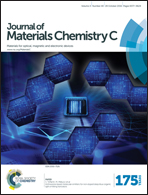The role of a few-layer TiOx surfactant: remarkably-enhanced succeeding radial growth and properties of ZnO nanowires†
Abstract
Mastery over the radial growth rate and geometrical size of a ZnO nanowire (NW) while preserving its excellent luminescent and electrical properties can not only offer a fascinating potential for future applications, but also represent a grand challenge. The NW radial growth remains very slow due to the preferred growth direction along its c-axis (less than 1 Å s−1), which hinders its applications in NW photonics such as waveguide lasing and resonant cavities. In this study, coating a few layers of TiOx on the NW matrix, through atomic layer deposition (ALD), was initiated intentionally before the re-growth. We found that this atomic layer TiOx could simply but surprisingly speed up the succeeding radial growth up to two orders of magnitude, with the epitaxial single-crystal wurtzite structure being well preserved. Unlike most other impurities, Ti element tends to “float” on the outer surface of the re-grown NWs, thus naturally guaranteeing the superior intrinsic electrical and luminescent properties. The ability to thrive the radial growth of ZnO NWs yet endow them with optimal integrated performance is exceptionally desirable for the design and construction of NW photonic devices.


 Please wait while we load your content...
Please wait while we load your content...